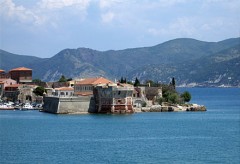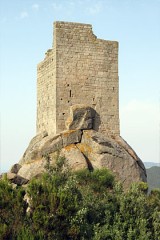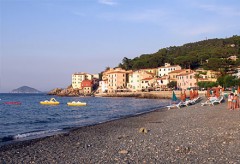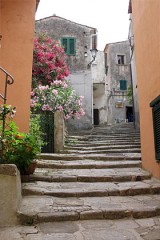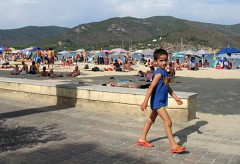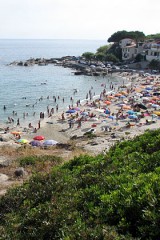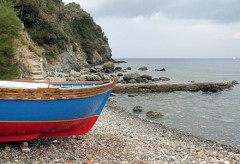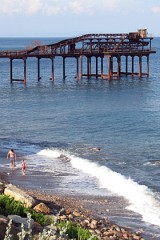Elba … Napoleon Slept Here
Sitting just to the west of the Italian mainland somewhat south of Pisa lies the island of Elba. It is common knowledge that Napoleon Bonaparte was exiled to Elba when nobody in France knew what else do with him but there is much more to this Tuscan island. So much more that it appears to have multiple personalities, which for the visitor is very desirable. There is the Elba with umbrella covered sandy beaches, pleasure boat harbors, and crowds of bathers. But there is also the Elba with a quiet rocky coastline, aromatic pine forests, and ancient hillside towns. There is also the Elba of ruins, archeological sites and abandoned mines. Napoleon Bonaparte’s s brief rule over the island in the 1800’s is but a suggestion of the push and pull of past powers.
Elba is ancient and complex geologically as well as culturally. It is fair to say that the mineral riches of the island have lured many throughout ancient times and continues to draw mineralogy pros and amateurs alike up into the hills. Elba has been inhabited since early peoples first learned how to cross the narrow stretch of sea to the island from what is now Piombino on mainland Italy. Stone age tools, some made from stone not found naturally on the island, that have been discovered on Elba attest to this. It was the Etruscans who located and first extracted the mineral wealth of copper and later, the rich iron ore deposits. Historians believe that the Iron Age in Italy began on Elba. These mineral treasures attracted the Greeks and the Romans along with Spaniards, French and English. Saracen pirates often raided the island and surviving fortifications in Portofarraio and elsewhere stand as reminders of how valuable Elba was. Mining, with various starts and stops due to the demands and consequences of the process (especially to the forests, depleted to fire the smelting furnaces in ancient times) continued through World War II. Elba has since turned its attention to tourism for current prosperity.
Elba is the largest of the Tuscan Islands at about 86 square miles which is quite a bit larger than Capraia. It is large enough to venture out for a day’s exploration knowing that the trip back will not be very long. We stayed on the coast to the west of the town of Procchio, which is centered on the Northern side of the island. Our rented apartment was within a 20 minute walk of Marciana Marina which served as our base for food shopping, dining out, and strolling around in the evening. This is a lively town that did not feel overcrowded with a good choice of restaurants and interesting small shops. In the evening, craftspeople set up their tables along the waterfront and a pleasant mixture of families, young lovers, and seniors were out enjoying the breeze of a warm July night. By night or by day, Marciana Marina had a nice balance of activity without a feeling of orchestrated tourism.
One issue that bears mentioning is that walking might best be limited to within the towns and along specific trails through the mountains. The roads are narrow and winding, often without shoulders. The drivers were not particularly bad (for normally lead-footed Italians) but there just isn’t much space to walk along the busier coastal roads without having to pay close attention to where you are and what is coming around the bend. Our initial thought of renting bicycles was negated by our first day’s walk to town because the hazards would have made it unappealing at best. Having a car to explore the island is a very big advantage though there are nice air conditioned busses that maintain a regular service around the island.
Above Marciana Marina at the foot of Monte Capanne, the largest mountain on Elba, are two small towns that retain their ancient roots. Marciana Castello is the older of the two and boasts fortifications that resisted attack by Dragut the corsair, one of the most legendary Saracen pirates to plunder the Mediterranean in the 1500’s. With nasty guys like Dragut appearing suddenly into the harbor it makes perfect sense why so many towns along the Italian coast were either perched high on rocky cliffs or sited well above the sea.
What appeals to us as charming and picturesque today was a matter of survival when these towns were built. Poggio Terme is also very beautiful and ancient with a small church dating from the 7th century. Above these towns, often with clouds grazing the upper ridge is the granite outcrop of Monte Capanne.
Tourism is a “sweet and sour” proposition to both the hosting region as well as the visitors. All travel destinations whose core values relate to history, culture and ancient architecture run a heavy risk of destroying the very thing that draws visitors by becoming too popular. Italy is at particular risk when developing new accommodations to house and entertain the large numbers of foreign tourists that converge on the country, especially in the summer. But, like the United States, Italians like to travel and vacation within their own country. Their interests are not always in sync with those on a pilgrimage to see ancient wonders. Elba, for the moment, is maintaining a nice balance. Aside from the inevitable cell phone towers (I will not diverge to that topic here), the countryside and the towns of Elba are not spoiled by many tall new structures. There are resorts of course but they tend to be off by themselves tucked into the coast and have not impacted on the older towns or on the rocky coastlines. Fortunately the temptation to develop large high-rise shore-line resorts has thus far been avoided.
Do not expect to be lone bathers on a pristine sandy beach. All of the nice beaches tend to be rather crowded and most have some degree of “creature comfort” by way of neatly arranged umbrellas and deck chairs that must be rented or belong to a particular resort.
You can always walk the seashore because nobody can actually “own” the coast for about nine meters from high tide. But, a resort can own the easiest access to a beach, especially when it is surrounded by rock cliffs. This is the most common method of making a good beach “exclusive”. Most Italians and many Europeans come to Elba to be at or on the sea. During the peak of the “vacation month” of August, these areas will definitely be very crowded.
But swimming and sunning can be just as enjoyable and quite a bit more tranquil from one of many rocky beaches or simply from a naturally accommodating stretch of rocks along the coast. Driving along the coastal roads you often see a small group of cars pulled off the road wherever space allows. These people have typically descended to the sea by way of a path to a usable and often beautiful place devoid of commercial intrusion. Do some exploring to find the best spot and then pack a lunch with bottles of water, some local wine and snorkeling equipment for a quiet day at the sea. A few things to remember along a rocky coast at the sea are to definitely have a pair of “water shoes” and watch out for jelly fish and sea urchins!
The sea surrounding Elba is clear, clean and easy to get to but it is the diversity of the island that has left a lasting impression and a desire to return. The topography and vegetation varies from one end of this small island to the other with rounded granite outcroppings and low-growing plants to the west, a forested interior of pine and chestnut, and the rugged multi-hued peaks and tree-covered hills of the mining centers to the east. One feels they have traveled far, based upon the views, in only 30 minutes.
The mining history and its remains are fascinating not to mention the fact that the mineral wealth of the ancient rocks of Elba have by no means been eliminated. Rock hunting for Neanderthal stone tools to semi-precious gems is still practiced. Attention to avoiding the well known vipers of Elba needs to be maintained whenever poking around their habitat but that should no more prevent exploration than does the rattlesnake keep people away from the Grand Canyon. Aside from the ever-present emperor of France, history is softly spoken in Elba but very much alive at every turn. It is said that Napoleon often sat by the sea on the west coast and gazed longingly at the island of Corsica in the distant haze. For those of us that have not lost an empire, reversing one’s view back to Elba is more than enough.

